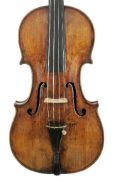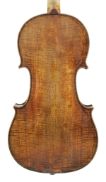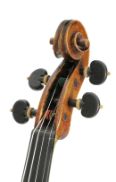Violin, Carlo Bergonzi, Cremona, after 1724
Printed label with a decorative border: “Carlo Bergonzi fece / in Cremona l’anno 1715” (15 handwritten)A dendrochronological report dates the most recent annual growth ring of the belly to 1724: Contrary to the date on the label, this violin is likely to have been made around the year 1730. Thus, the instrument is one of Bergonzi’s early works, as the stylistic features confirm. The high arch and the cut of the f-holes, above all, reflect the influence of Bergonzi’s master, Vincenzo Rugeri. The body is short and has distinctive, pointed corners. The two-piece belly exhibits very narrow annual rings and a marked hazel figure in some areas. The divided, quarter-cut back displays close, intense flames. The wood looks very much like that of the back plate of another violin Bergonzi also built before 1730. The flames on the ribs are wider and less vivid than on the back. The arch is high, rising from a shallow fluting channel to a high ridge, above all on the back plate. The fine and very regular purfling is positioned quite close to the edge, letting the edges appear delicate. Bergonzi’s unique style manifests itself in the perfectly regular and expertly carved scroll with long, thin eyes and deeply cut volutes whose delicate edges make for graceful contours. The golden-yellow ground is coated with a very intense, red-brown color varnish that is still easily visible, above all on the back and the ribs. The pronounced craquelure of the original varnish layers can still be detected in the fluting of the C-bouts of the belly.





